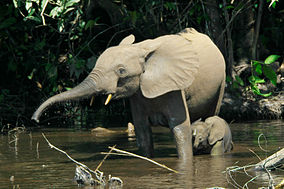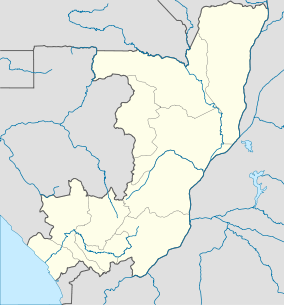- Nouabalé-Ndoki National Park
-
Nouabale-Ndoki National Park IUCN Category II (National Park)
Forest elephants in the Mbeli River, Nouabalé-Ndoki National ParkLocation  Republic of the Congo
Republic of the CongoCoordinates 2°28′N 16°27′E / 2.467°N 16.45°ECoordinates: 2°28′N 16°27′E / 2.467°N 16.45°E Area 3921.61 km²[1] Established 1993 Governing body Ministry for National Forestry Commission Nouabal-Ndoki National Park is a national park in the Republic of the Congo. Established in 1993, north of Congo, it is mostly populated with elephants, apes, ranging from Western Lowland Gorillas to chimpanzees and bongo. It is 3,921.61 km2 (1,514.14 sq mi) of pristine tropical rainforest with no human habitation within it and with least habitation in the peripheral villages. The forests have a rich biodiversity of 300 bird species, plus 1,000 plant and tree species which include endangered mahoganies.[1][2][3][4]
In a conference of the Ministers of Forests of Central African Forest Commission (COMIFAC), it had been resolved to establish within the Congo basin, the Sangha River Tri-national Protected area (STN) with a total area of 2,800,000 ha (6,918,951 acres) encompassing the Dzanga Sangha Special Reserve (the second largest area in the world) in the Central African Republic, which incorporates within its ambit the Nouabalé-Ndoki National Park in the Republic of Congo (Brazzaville) and the Lobéké National Park in Cameroon.[5][6] The concept of creating reserved parks emerged in the 1980s with the realization that wild roaming elephants which moved freely in the entire region of the three parks needed to be protected from poachers and the logging industry.[7]
The Nouabal-Ndoki National Park, managed by the WCS Congo jointly with the Ministry of Forestry, is one of the five protocols signed between them that specifies the responsibility of each partner of the protocol to ensure protection of the areas to defined international standards.[4]
Mbelibai is a specific area within the park where the gorillas reside and visitors visit regularly to see them.[8]
Contents
History
Plans to establish the Nouabale-Ndoki National Park were initiated in 1991 by the Wildlife Conservation Society (WCS) and the Government of Congo with support from USAID as a transboundary collaborative project. It also involved a progression of interaction with local, regional and national authorities. It was finally established in September 1993 covering an area of 392,169 ha (969,070 acres) between the North-eastern Sangha Province and the north-western Likouala Province of Congo.[1] In 1999, the timber company CIB (Congolaise Industrielle du Bois) and the local community joined hands with WCS and the Government of Congo to create an entity that would minimise the negative impacts of logging on the national park. In 2001, the park area was extended with part of a neighbouring logging concession known as the Gouloago triangle getting annexed to this park. The German logging firm surrendered its rights over 100 km2 (39 sq mi) of the Goualougo Triangle under its lease hold to be merged with the national park, and also resolved to ban hunting. While logging operations (particularly of two species of the African Mahogony for high-grade timber) have taken place in many forest regions in the northern Congo to a limited scale, this park has been free of any such operations. This has resulted in the fact that it has been beneficial to effective preservation and growth of population of the wild life and natural habitat of the forests in the park.[1][8][9][10][11]
Geography and climate
The protected area, which is part of the Sangha River Tri-National Protected Area (STN) is drained mainly by the Sangha River, a tributary of the Congo River. Part of the forest is still inaccessible and remains unexplored. It is a swampy tropical forest in lowlands that are part of the Congo River drainage basin. This park, along with the other two reserved parks within the larger Sangha Reserve, is secluded from all economic activity involving roads and human interference, which has resulted in its maintenance as a pristine rain forest.[6][8][8][12] The park lies within the forest area of Congo which forms 11% of the total area of the country. It has been further demarcated into protected areas, cleared areas known as Bai and Yanga, two seasonal zones for use by nomadic people, hunting areas reserved for employees, protected zones that act as prey zones for hunting, hunting zones for local community, and sacred sites.[9]
The park has a humid climate and gets, on an average, 1,250 mm (49 in) of rain a year. The rainy season is August to November and the dry season is December to February. The plants include a collection of different types of mahoganies.[3]
Wildlife
Fauna
There are many kinds of species living in the park. The National Geographic Society has observed that the park may have the largest concentration of wild life per square mile than any other place in Africa. The most prominent species are primates. There are Colobus monkeys (black-and-white Colobus, red Colobus), the endangered lowland Gorillas, chimpanzees, and moustached guenon monkeys. The park plays host to over 300 different bird species. Some of the important species are the eagles, hawks, owls, scavenging vultures, and wading herons. There are also the rare African Forest Elephant, dwarf forest Buffalo, leopards, bongos, and blue duikers. There are different kinds of wildlife in the park.[12][13][14] Crocodiles and blood-sucking insects are also part of the forest's species.[12] Herpetofauna studies have been conducted in four specific areas of the park. These studies have established 20 amphibian and 14 reptile species in the southern edge of the park; of these, the frog species are Aubria masako, Amietophrynus regularis, Cryptothylax greshoffii, Hyperolius balfouri, H. brachiofasciatus, Leptopelis brevirostris and L. calcaratus meridionalis.[15]
Parrots are also seen in the park area. Forest elephants create space by clearing the forest for other animals to move. Horned antelopes with 12 lb (5.4 kg) tops number 100 per 1 km2 (0.39 sq mi). According to a Pygmy legend, a Congo based long-necked reptile, known as Mokele-mbembo killed elephants with its huge frontal horn.[8]
Mbelibai is a specific 3 km2 (1.2 sq mi) area within the park which is particularly rich in gorillas, with 180 western lowland gorillas reported here. It also contains many monkey species, and nine of them have a population density of 50 per 1 km2 (0.39 sq mi). The monkey species found here are the black-and–white and red Colobus, mustached and crowned guenon, grey-cheeked mangabeys and many others.[8][16]
Flora
The trees and plants flourish within this climate. Nouable-Ndoki National Park is a very lush rainforest. It is home to 24 distinct types of vegetation. However, the dominant vegetation is of Gilbertiodendron dewervei (G. dewevevri in the upland region and away from water courses in large areas; mixed and swamp forests are also a feature. The forest has many “bais” meaning ”cleared areas”. Over 1000 different plant and tree species have been identified.[2][13] G. dewevevri is a supra-annual seed crop and it is “thought that mast fruiting may have occurred to combat seed production through predator satiation.” Its characteristics are defined as “79% of its stems above 10 cm at breast height and 88% of the basal area.” These seeds are destroyed by beetles. However, they form the major food source for a large number of mammals such as rodents, duikers (cephelophus spp.), pigs (Putamoechoerus porcus and hylochoerus meinertzhagen) , buffalo (Syncerus caffer), elephants, and particularly gorillas.[17]
Conservation measures
Conservation efforts undertaken are not limited to the Nouabale-Ndoki National Park alone but also to the two other parks of the tri region, and also the entire Sangha River Tri-national Protected Area that encompasses more than 96% of the land area. The countries who have formed the tri-national organization under a trans-boundary program through the efforts of the World Wide Fund for Nature (WWF) are the Central African Republic, the Congo and the Cameroon. This organizational effort has ensured appropriate actions being implemented related to anti-poaching, research and the promotion of tourism to the rain forests. A regular feature of this effort is the meetings that are held at regular intervals of the three park-administrations, as well as the prefects of the three countries. Patrolling of the parks is carried out by regular joint patrols to ensure that poaching, smuggling of ivory and unauthorized fishing and carriage fire arms do not happen in the reserve park.[6][7] Visitors can visit the park only in a group as part of an organized tour arranged by professional wild life tour operators.[12]
Conservation measures are supported by the German Cooperation of Technical Collaboration (GTC) in Central African Republic and Cameroon, and the World Wildlife Fund for Nature (WWF) and Wildlife Conservation Society (WCS - New York) in the Congo. A trust fund, flush with funds, has also been created for the purpose of conservation of the parks.[6][7] The National Park has also its several research projects that are financially supported by USAID-CARPE, U.S. Fish & Wildlife Service, Colombus Zoo, and the MacArthur Foundation. Consequent to extensive international support, the park is now considered not only nationally important, but also an internationally recognised conservation area of immense importance, with a very well established infrastructure, skilled personnel, and substantial economic backing.[11]
- Protection
In the past, protection technology had been limited for rangers. However, now, they have been using detectors to catch criminals hurting the park. The rangers of Nouabalé-Ndoki National Park have a group known as 'eco-guards'. The 'eco-guards' are under the supervision of the MFEE (Ministry of Forestry Economy and the Environment). With the MFEE/eco-guards, it has been ensured that no illegal human activities take place in the park such as poaching.[2] Apart from the rangers, the local community of the Ba’Aka also provide their local knowledge base inputs to promote sustainable preservation and conservation of the forests in the park.[2][7]
See also
- Rainforests
- African Wildlife
- Republic of the Congo
- Monkeys
- Elephants
- Antelopes
- Cats
References
- ^ a b c d "Chapter 2 Study Area, Population and Methods" (pdf). Chesterrep.openrepository. pp. 20–40. http://chesterrep.openrepository.com/cdr/bitstream/10034/77614/3/chapter%202.pdf. Retrieved 2010-09-20.
- ^ a b c d "Nouabale-Ndoki National Park". WCS Congo. http://www.wcs-congo.org/projects/nouabale.htm. Retrieved 2010-09-20.
- ^ a b "Incognita: Nouabale-Ndoki National Park." Travel Africa: 16 Oct. 2009.
- ^ a b "Welcome to WCS-Congo". WCS-Congo. http://www.wcs-congo.org/. Retrieved 2010-09-19.
- ^ "Lowland Gorilla Sangha National Park". The Zambazi Safari and Travel Co. Ltd. http://webcache.googleusercontent.com/search?q=cache:B6VYqa29X70J:www.zambezi.com/location/congo_basin_tri_national_park+Nouabal%C3%A9-Ndoki+National+Park&cd=15&hl=en&ct=clnk&gl=in. Retrieved 2010-09-18.
- ^ a b c d "The Sangha River Tri-national Protected Area (STN)". Dazanga Sangha Central African Republic. http://www.dzanga-sangha.org/drupal/node/309. Retrieved 2010-09-19.
- ^ a b c d "Sangha Tri-National Landscape" (pdf). Worlld Wild Life Fund. http://www.worldwildlife.org/what/wherewework/congo/WWFBinaryitem8796.pdf. Retrieved 2010-09-19.
- ^ a b c d e f Riley, Laura; William Riley (2005). Nature's strongholds: the world's great wildlife reserves. Princeton University Press. p. 46. ISBN 0-691-12219-9. http://books.google.com/books?id=icMuBQhW4vgC&pg=PA46. Retrieved 2010-09-21.
- ^ a b "Protected areas of Congo" (ppt). Congo BioDiversity: Description. Wild Life Conservation Society (WCS). http://www.un.int/wcm/webdav/site/congo/shared/documents/NOUABALE-NDOKI%20NATIONAL%20PARK.pps. Retrieved 2010-09-20.
- ^ "Congo BioDiversity: Description". Slide 4. Permanent Missions of the Republic of Congo. http://www.un.int/wcm/content/site/congo/cache/offonce/pid/2479. Retrieved 2010-09-20.
- ^ a b "Congo Nouabale-Ndoki National Park Guided Tour - 11 Day". Wiled Frontier. http://africanadrenalin.com/WildFrontiers/congo_nouabale_ndoki_national_park_guided_tour.htm. Retrieved 2010-09-20.
- ^ a b c d "Congo Republic: Nouabalé-Ndoki National Park". Wild Life Hot Spots. http://www.wildlifehotspots.com/nouabalendokinp.html. Retrieved 2010-09-20.
- ^ a b "Nouabalé-Ndoki National Park". Encyclopaedia Brittannica. http://www.britannica.com/EBchecked/topic/1540231/Nouabale-Ndoki-National-Park. Retrieved 2010-09-20.
- ^ Berg, Maria. "Congo Republic Nouabal-Ndoki National Park." 16 Oct. 2009.
- ^ Kate Jackson & David C. Blackburn (2007). "The amphibians and reptiles of Nouabale-Ndoki National Park, Republic of Congo (Brazzaville)" (pdf). Whitman Education. pp. 149-. ISSN 0036-3375. http://people.whitman.edu/~jacksok/Ndoki%20herps.pdf. Retrieved 2010-09-20.
- ^ "Mbeli Bai, Nouabale-Ndoki National Park, R. P. Congo". Dept. of Anthropology Washington University. http://webcache.googleusercontent.com/search?q=cache:q6lTM6yTeCwJ:weber.ucsd.edu/~jmoore/apesites/MbeliBai/MbeliBai.html+Nouabale-Ndoki+National+Park&cd=11&hl=en&ct=clnk&gl=in. Retrieved 2010-09-20.
- ^ Blake, Stephen; Fay, J. Michael (1997). "Seed Production by Gilbertiodendron dewevevri in the Nouabale-Ndoki National Park". Journal of Tropical Ecology 13 (6): 885–891. doi:10.1017/S0266467400011056. JSTOR 2560244.
 Protected areas of the Republic of the Congo
Protected areas of the Republic of the CongoNational Parks Nature reserves Lac Télé · Léfini · Lesio-Louna · Lossi · Mangrove · Ntokou-PikoundaCategories:- IUCN Category II
- National parks of the Republic of the Congo
- Protected areas established in 1993
Wikimedia Foundation. 2010.



